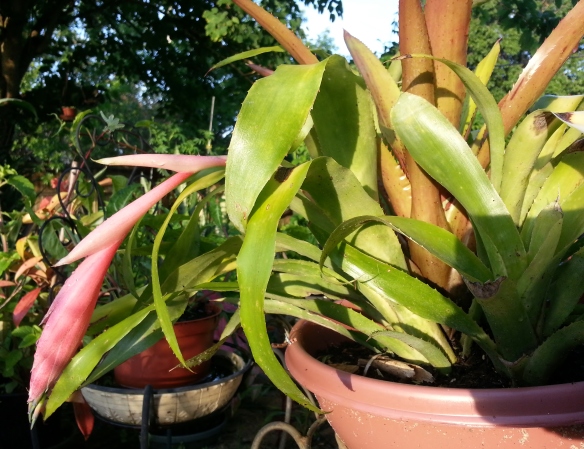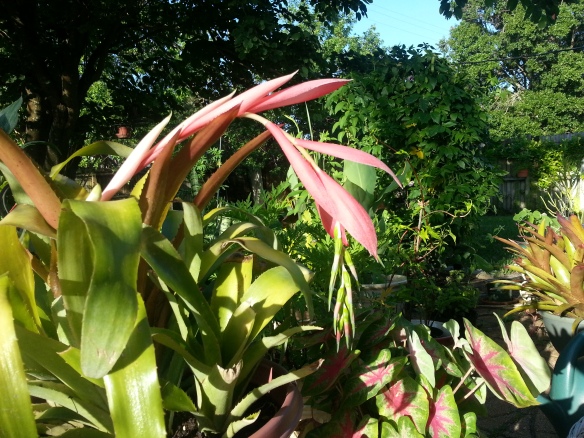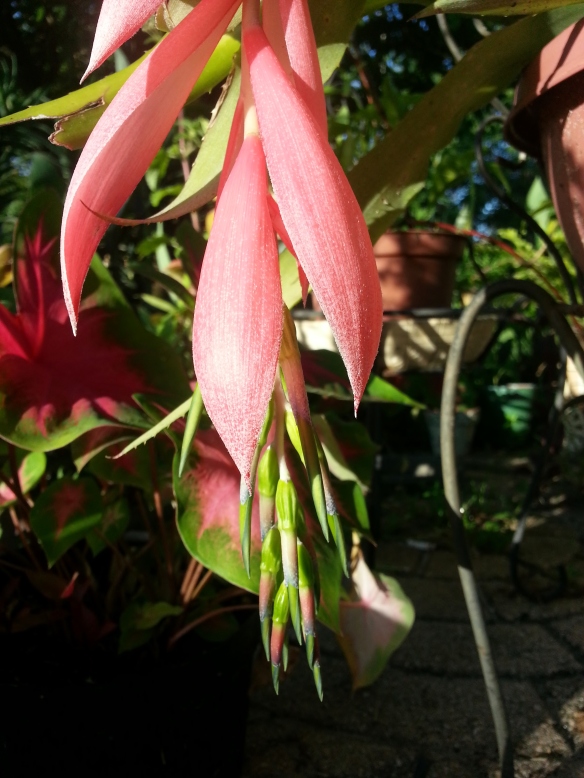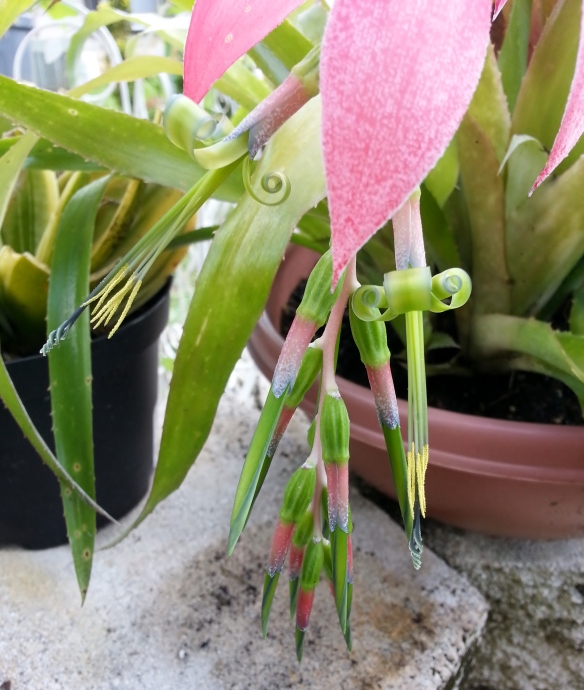Billbergia Windii is one of the oldest hybrids in the bromeliad family, the result of crossing B. Nutans with B. Decora in the 1870s at the National Botanic Garden of Belgium.
As you see in the picture, strappy yellow/green leaves grow tall and tubular, creating water collecting “tanks” in the plant’s center. Throughout the year, organic detritus builds up in these “micro-oceans,” feeding and prepping the plant for bloom time.
B. Windii’s magnificent flowers appear overnight (literally!) as a pendulous inflorescence of rosy-pink bracts. Within a few days, long yellow and pink flowers–margined by blue and green–emerge from the tip:
Here’s a closer look:
Hard to imagine, there’s more to come! Each inflorescence takes a full week to open, with the perianth rollback signalling the final stage:
Although B. windii is an epiphyte, it grows well in soil, too. With Florida’s intense summers, morning sun and shade in the afternoon keeps the colors vibrant without risking leaf burn. In other parts of the country, full sun is recommended.
To learn more about billbergias and other bromeliads visit the Internationall Bromeliad Society Journal Archives.
Until next time…..
🙂 🙂 🙂
Related articles
- Bromeliads My Favorite Decorating Plant (joeruggieroathome.com)
- “Matchstick” Bromeliads and Gilbert on his Sleeper in the Sun (gottopickapocketortwo.com)
- Who Knows This Plant (gwenniesgarden.wordpress.com)
19 thoughts on “Billbergia Windii, a most beautiful bromeliad!”
Comments are closed.





Beautiful!
Thanks, Bridget! your garden is looking beautiful as well! Summer has struck Ireland, bigtime, yeah?!?
Awesome! I think I have a Bilbergia nutans-Queens Tears/Angels Tears. A friend of mine had several pots and was good enough to share. Mine hasn’t flowered yet, but his has.
I’ve got 6 and only 2 routinely flower. While doing research for this post, I came across a bromeliad expert’s article in which he claimed B. Windii are “rare to flower.” While I wouldn’t got THAT far, I think they can be fickle, for sure, esp.when used as houseplants.
Beautiful plant.. although it once again looks familiar I won’t commit to knowing it…
Hi Bulldog!
Thanks for taking the time to comment! I imagine you’d have great success growing these outside where you are!
It is just beautiful.
Thank you, Dee! I so appreciate that you took the time to drop in and comment! 🙂
We tried a bromeliad once as a houseplant. You can probably guess how long it lasted. 😉 I’ll stick to admiring them in your photos and at the Arboretum in DC.
This is so essential post. This information helps them who are new gardeners.
Thanks for helpful post for us.
Bromeliad
Thank you alexalen! I clicked on your gravatar and see you work for Plant Biotech in Australia? What an interesting company to focus solely on bromeliads! My interest is definitely piqued. 🙂
Thanks for posting this. I had an unknown (to me) Bromeliad that I was able to pretty quickly narrow down to being a Billbergia, but had problems from there. At first I thought it might be a B. nutans, but the leaves didn’t quite look like it. Then I found your photo- now I’m pretty sure that it’s a B. windii. The thing that still puzzles me is that I see other photos of it on the internet, where the leaves look more grass like and always greener. Yours likes more like mine- which has yellowish-green leaves. In fact your description reads “strappy yellow/green leaves”, but everyone else refers to them as being “green”. How confident are you that this is a B. windii, and why do you think mine is more yellowish? Do you think it means it needs fertilizer or something? (It gets plenty of light)
I’m fairly confident but so many of these billbergias look SO similar it’s hard for amateurs like me to tell!
Regarding the yellowish leaves, you could try hitting the plant with some ironite (or any similar product with iron in it) Sometimes Ironite can be hard to find at the store/nursery but Amazon always has it!
(p.s. I’ll do a little more research on B. windii in case I’m in error. )
Happy Halloween!!!
Thanks for the suggestion about the ironite- I’ll look into it. Also, just to share something else I learned after leaving my last message- another site suggested that if your Billbergia is turning yellowish, give it LESS light. As I mentioned, mine is getting plenty of light- maybe too plenty. I’m also going to try that suggestion. I’ll have to execute them separately, as I’d like to know whether it’s the iron or the light, in case I do get a favorable response.
Also,
I just looked into buying Ironite- it doesn’t seem to be that hard to find. It’s available at both Lowes and Home Depot. As you said, it’s also on Amazon.com- but you really pay for shipping. You’ll pay at least $18 with shipping to get 10 lbs. Going the Home Depot/Lowes route will also cost you about $18, but you’ll get 40 lbs.
I am also going to try using some Fish based fertilizer- specifically, Alaska All Purpose Dry Fertilizer. I read that this has minimal odor for fish based product, important as my plant is kept indoors.
Let me know how you feel about the Alaska Fertilizer. I’ve never tried any fish based products like that an am curious about the results.
Karen,
I just received the fertilizer from Amazon yesterday. It looks like Guinea Pig/ Rabbit chow. It does have a fishy smell, but not too bad. It’s made with alfalfa, fish, blood, feather and kelp meals. It’s got a 6-4-6 composition. It’s slow release, so it won’t burn. I’ll let you know how it goes. By the way, I’ve been reading through your blog and really enjoy it. I’ve been learning a lot. You are a very good writer, however there is one thing I suggest. When referring to an organism by genus and species, you should always use upper case for the the first letter of the Genus and lower case for the species. I know that sounds fussy, but it’s always been a pet peeve of mine (I think picked up from a college professor at some point).
On the original subject of this Billbergia, am I mistaken or is this the same plant you referred to as an “Aechmea Gracilis” (your use of capitalized species name, not mine 😉 in your June 1, 2012 entry?
Randy
You’re right! I originally thought the billbergia was an Aechmea! I’ve meant to go back and change it, but kept forgetting. Heading off to do it right now!